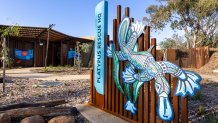The San Diego Zoo is joining an international collaboration project to ensure the survival of one of nature's truly unique animals — the platypus.
Scientists with the San Diego Zoo Wildlife Alliance are working with the Taronga Conservation Society Australia, the organization behind the Taronga Western Plains Zoo Dubbo and Taronga Zoo Sydney, and the University of New South Wales to conserve the platypus.
The platypus has a beaver-like tail, waterproof fur, a flat bill and webbed feet like a duck. They are mammals, but lay eggs, and have lived for thousands of years in eastern Australia and Tasmania. Still, not much is known about these creatures, the San Diego Zoo and Wildlife Alliance says.
The platypus species is on track to continue declining, according to zoo. The mammal's status is "near threatened," according to the International Union for Conservation of Nature's Red List of Threatened Species.
Get top local stories in San Diego delivered to you every morning. Sign up for NBC San Diego's News Headlines newsletter.
The geographic range for the platypus has declined 21% and 40% more is anticipated to decline over the next 50 years, according to the zoo. As such, there is an urgent need for more research on climate impacts and triggers for wild interventions.

“In 2019-2020, we saw just how vulnerable platypus are to prolonged drought, megafires and floods, which are only going to become more common as a result of a changing climate,” said Taronga and UNSW research associate Dr. Tahneal Hawke.
Local
The research program aims to sharpen the conservation strategy for the platypus by learning more about how the mammal is responding to climate change and figuring out what interventions are needed to protect the animal.
As part of this huge research project, four new platypuses have joined the family at the Taronga Western Plains Zoo's Platypus Rescue HQ. Newly opened in February 2024, the HQ is the world's largest facility dedicated to conserving the platypus. If need be, it has the capacity to shelter 65 platypuses at once in times of extreme weather events.

What's the program's crucial aim? Breed more platypuses! Only 23 puggles (yes, that's the word for baby platypuses) have been born at zoos since 1943 (that's 81 years). Not much is known about what leads to platypus reproductive success or failure, which is why the research must be done.
The four new platypuses are poised to make up the first breeding population at Platypus Rescue HQ in Dubbo, Australia. The facility allows the platypuses to swim in waterfalls, streams and dig cozy burrows with plenty of space.
“We hope that the refuge area inside Platypus Rescue HQ never needs to be used, but with increasing impacts of climate change and extreme weather we now have the capacity to undertake emergency rescue interventions,” said Taronga Cultural Programs Coordinator Kirsty Hargraves.
Scientists hope using the facility, along with wild population monitoring, will help with emergency response strategies for platypuses in the future, and develop a genome resource bank and genetics database to better protect wild platypus populations.
“Platypuses play a crucial role in maintaining the health of their native watersheds and uniquely contribute to our planet’s biodiversity,” said Dr. Hendrik Nollens, vice president of Wildlife Health with San Diego Zoo Wildlife Alliance.

Here's what makes the platypus a unique animal
- The platypus has a beaver-like tail, waterproof fur, a flat bill and webbed feet
- They (along with the echidna) are the only living mammals that lay eggs (called monotremes)
- Adult male platypuses have venomous spurs for defending mates and territory, an unusual trait among mammals
- Unlike other mammals, females don't nurse their young with nipples, instead they ooze milk from skin patches
- "Platypus" comes from the Greek word for "flat foot." The correct plural is "platypuses," preferred over "platypi"
- It swims with its eyes and ears closed while underwater, detecting prey with 40,000 electroreceptors
- It can detect electrical impulses generated by living creatures
- Its bill is actually soft and pliable, not hard like a duck's bill



